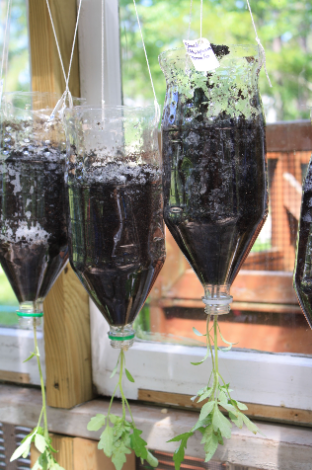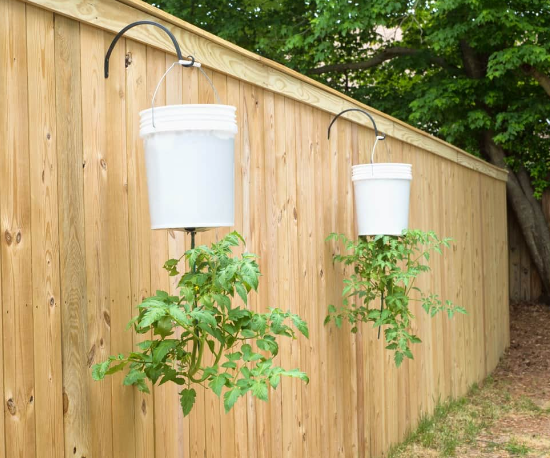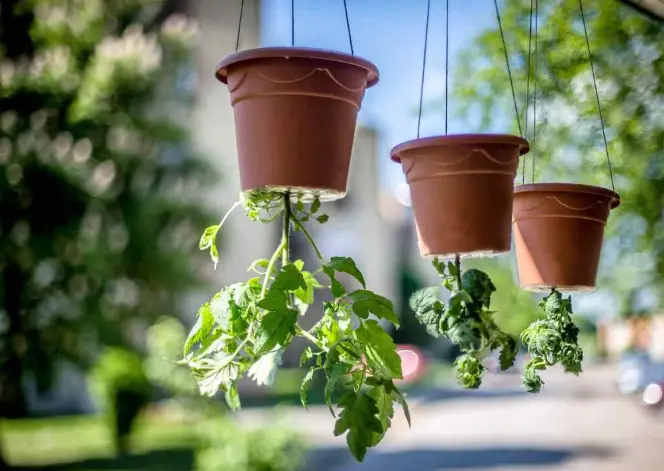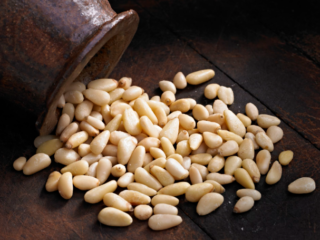Although it may seem unconventional, growing tomatoes upside down is gaining popularity among gardeners. This method involves suspending tomato plants in containers, allowing gravity to work its magic. Let’s explore the benefits, challenges, and how you can set up your own topsy-turvy tomato garden.

Advantages of Upside-Down Tomato Growing:
- Limited Space Solution:
- If you’re short on garden space but crave homegrown tomatoes, this method is perfect.
- Even a sunny balcony or patio can host your upside-down tomato plants, yielding a generous harvest.
- No More Stake Struggles:
- Traditional staking can be a hassle – stakes break, interfere with plant growth, or fail to support the plant.
- With upside-down tomatoes, forget about staking woes!
- Less Disease and Pests:
- Hanging tomato plants reduce exposure to pests like cutworms and ground fungus.
- Healthier plants mean less work for you.
- Easy Setup:
- Creating an upside-down planter is straightforward and requires no digging.
- Perfect for beginners and seasoned gardeners alike.
- Weed-Free Environment:
- Traditional soil-based gardening often means battling weeds.
- Upside-down planters minimize exposed soil, leaving no room for weeds to take hold.
- Improved Air Circulation:
- Suspended containers allow excellent air movement around the plant.
- Proper circulation contributes to plant health.
- Portability:
- Unlike in-ground plants, you can move your upside-down planter as needed.
- Place it where sunlight is abundant, and even bring it indoors during chilly nights.
Challenges to Consider:
- Watering:
- Container gardening, including upside-down tomatoes, demands careful watering.
- Containers dry out quickly, but overwatering can lead to rot.
- Hardware Weight:
- Upside-down tomato planters can be heavy.
- Ensure proper hanging hardware or DIY skills to prevent disasters.
- Sunlight Requirements:
- Tomatoes thrive on sunlight.
- If your patio or balcony lacks sun exposure, your plant won’t produce as expected.
Creating Your Own Upside-Down Tomato Planter:

growing tomatoes upside down
- Materials Needed:
- A 5-gallon bucket (or similar container)
- Tomato seedlings
- Sunlight
- Steps:
- Cut a hole in the bottom of the bucket.
- Line the hole with aluminum foil.
- Fill the bucket with soil.
- Plant your tomato seedling through the hole.
- Hang the bucket upside down in a sunny spot.
Other Plants That Can be Grown Upside Down?
Growing plants upside down is an innovative approach that saves space, minimizes pests, and provides better air circulation. Let’s explore some plants that thrive when grown topsy-turvy:
- Tomatoes:
- Tomatoes are a popular choice for upside-down gardening.
- To care for them, keep the planter in bright sunlight and water when the top inch of soil is dry.
- Regular pruning helps remove dead vines and leaves, promoting juicier, healthier fruit.
- Opt for indeterminate (vining) varieties with small fruits like cherry, grape, and Roma to prevent the planter from becoming too heavy.
- Peppers:
- Various pepper varieties can also be grown upside down.
- Small fruit types, such as jalapenos, habaneros, and cayenne, work best.
- These peppers thrive without putting excessive weight on the planter.
- Eggplants:
- Eggplants adapt well to upside-down gardening.
- Choose compact varieties and provide them with adequate sunlight and well-draining soil.
- Cucumbers:
- Cucumbers can be grown upside down, especially bushy or compact varieties.
- Ensure proper support for the planter to prevent it from tipping over.
- Squash:
- Some squash varieties work well when suspended.
- Look for smaller types like zucchini or summer squash.
- Beans:
- Bush beans are excellent candidates for upside-down planters.
- Their lightweight nature makes them ideal for this method.
- Herbs:
- Basil, parsley, and lemon verbena thrive when grown upside down.
- Creeping herbs like oregano and creeping thyme also do well in this setup
How to Water Plants Grown Upside Down?

growing tomatoes upside down
Watering upside-down plants can be a bit tricky, but with the right techniques, you’ll keep your plants hydrated and thriving. Let’s explore some methods:
- Choose the Right Planter:
- When selecting an upside-down planter, look for one with a built-in sponge or water reservoir. These features help keep the roots cool and prevent rapid soil drying.
- Consider adding lightweight water-retention materials to the potting mix:
- Perlite or vermiculite: These absorb and retain moisture.
- Polymer crystals: These improve water retention.
- Water Slowly and Evenly:
- Water your upside-down container plants from the top. Gravity will pull the moisture evenly through the potting mix.
- The key is to water slowly to ensure even absorption.
- Allow water to trickle through the bottom of the container.
- Monitor Daily:
- Containers dry out quickly, especially during hot weather.
- Aim to water your upside-down plants daily.
- However, be cautious not to overwater, as it can lead to root rot and other water-related issues.
- DIY Watering Solutions:
- Upside-Down Water Bottle Method:
- Clean an empty plastic bottle.
- Make small holes in the cap.
- Cut off the bottom of the bottle.
- Fill the bottle with water.
- Invert and insert the bottle into the soil near the plant.
- Self-Watering Planter:
- Fill a bottle with water and place the cap back on.
- Flip the bottle upside down and bury it about two inches into the soil.
- As the soil dries out, fluid will slowly drip from the bottle, providing just the right moisture for your plant
- Upside-Down Water Bottle Method:
What is The Best Soil For Growing Plants Upside Down?
When it comes to growing plants upside down, choosing the right soil is crucial for their success. Let’s explore the best options:
- Nutrient-Rich Potting Soil:
- Add Mulch or Peat Moss:
- To maintain even moisture levels, consider adding a layer of mulch or peat moss to the top of the soil.
- These materials help retain water and prevent rapid drying out.
- Hydroponic Mix:
- For certain plants, especially those grown indoors, consider using a hydroponic mix.
- These mixes hold water well and provide essential nutrients.
- They are particularly useful for upside-down houseplants or herbs.
- Well-Draining Soil:
- Regardless of the specific mix, ensure that the soil is well-draining.
- Upside-down planters can dry out faster due to increased airflow and heat exposure.
- Good drainage prevents waterlogged roots and promotes healthy growth.
How to Fertilize Plants Grown Upside Down?
Fertilizing upside-down plants is essential to ensure their health and productivity. Here are some tips to keep your hanging garden thriving:
- Choose the Right Soil Mix:
- Start with a well-draining potting mix that is nutrient-rich.
- Consider adding compost or slow-release fertilizer to boost nutrient levels in the soil.
- Top-Down Fertilization:
- Since your plants are hanging upside down, you’ll fertilize from the top end of the pot.
- Dilute liquid fertilizer according to the package instructions and apply it directly to the soil surface.
- Water will carry the nutrients downward to the roots.
- Frequency of Fertilization:
- Regular feeding is crucial for healthy growth.
- Follow the recommended fertilization schedule for the specific plant you’re growing.
- Generally, once a month during the growing season is a good rule of thumb.
- Use Balanced Fertilizers:
- Look for a balanced fertilizer with equal proportions of nitrogen (N), phosphorus (P), and potassium (K).
- For example, a 10-10-10 or 14-14-14 blend works well for most plants.
- Avoid Overfertilization:
- Upside-down planters have limited soil volume.
- Don’t overdo it – excess fertilizer can harm the roots.
- Follow the package instructions carefully.
- Organic Options:
- Consider using organic fertilizers like compost tea or fish emulsion.
- These provide slow-release nutrients and improve soil health.
- Monitor Plant Health:
- Observe your plants for signs of nutrient deficiencies (yellowing leaves, stunted growth, etc.).
- Adjust your fertilization routine accordingly.
Common Mistakes to Avoid When Growing Plants Upside Down?
Growing plants upside down can be rewarding, but there are some common pitfalls to avoid. Let’s explore these mistakes and how to steer clear of them:
- Gravity Challenges:
- Root Escape: While plant foliage adapts well to gravity, the roots may escape the pot. Ensure they remain contained.
- Weight Distribution: Heavy crops can strain the roots and cause issues if the planter isn’t sturdy enough.
- Sunlight Considerations:
- Overhangs and Eaves: Hanging planters may limit sun exposure due to nearby overhangs or roof eaves. Choose a sunny location.
- Plant Contortion: Plants naturally reach for sunlight. Monitor their growth to prevent odd shapes.
- Soil Dryness:
- Upside-down planters dry out faster due to increased airflow and heat exposure.
- Regularly check soil moisture and water accordingly.
- Plant Hormones (Auxins):
- Natural plant hormones cause stems to grow upward, leading to U-shaped and fragile stems.
- Prune and train your plants to maintain a healthy shape.
Table Summarizing The Key Points Bbout Upside-Down Gardening:
| Aspect | Upside-Down Gardening |
|---|---|
| Advantages | – Saves space: Hang plants to free up lawn or patio area. – Reduces pest issues: Pests can’t easily reach foliage. – Easier watering and fertilizing. – Increased light exposure. – Better airflow. – Low maintenance. – Less stress on plants. |
| Disadvantages | – Gravity affects roots. – Plants may contort to reach sunlight. – Soil dries out faster. – Weight of moist soil and crops. |
| Common Plants | – Tomatoes, peppers, eggplants, cucumbers, squash, beans, and herbs. |
| Soil Mix | – Nutrient-rich potting soil with good drainage. – Add mulch or peat moss for moisture retention. |
| Fertilization | – Top-down application of balanced liquid fertilizer. – Monitor plant health and adjust feeding. |
| Avoid Mistakes | – Prevent root escape. – Ensure proper sunlight. – Avoid soil dryness. – Be mindful of plant hormones. |
Frequently Asked Questions (FAQs) About Upside-Down Gardening
- What happens if you grow a plant upside down?
- When you grow a plant upside down, gravity still affects it. The roots will turn and twist to extend towards the ground. Some plants can thrive in this manner, while others may struggle.
- What are the advantages of upside-down gardening?
- Saves space: Hanging plants free up lawn or patio area.
- Reduces pest issues: Pests can’t easily reach the hanging foliage.
- Easier watering and fertilizing: Direct delivery to the roots.
- Increased light exposure: Sunlight reaches leaves more effectively.
- Better airflow: Reduced mold and fungi issues.
- Low maintenance: No weeding or staking required.
- Less stress on the plant: Gravity aids in nutrient absorption.
- What are the disadvantages of upside-down gardening?
- Gravity: Roots may escape the pot due to gravity.
- Reaching for the sun: Plants may contort to reach sunlight.
- Soil dryness: Containers dry out faster.
- Weight: Upside-down planters can be heavy.
- Can bulbs be grown upside down?
- Bulbs naturally know which way is up, so they will find their way upwards and outwards even if planted upside down.
- However, planting them right-side up ensures optimal growth and energy use.
- Which plants can be grown upside down?
- Common plants for upside-down gardening include tomatoes, peppers, eggplants, cucumbers, squash, beans, and various herbs.
- What type of soil mix is best for upside-down gardening?
- Use a nutrient-rich potting soil with good drainage.
- Consider adding mulch or peat moss for moisture retention.
- How should I fertilize plants grown upside down?
- Apply balanced liquid fertilizer from the top.
- Monitor plant health and adjust feeding as needed.
- What are some common mistakes to avoid in upside-down gardening?
- Prevent root escape.
- Ensure proper sunlight exposure.
- Avoid soil dryness.
- Be mindful of plant hormones.
- Can I grow strawberries upside down?
- Yes! Upside-down strawberry planters are popular.
- Follow similar principles as with other plants.
- Is upside-down gardening suitable for beginners?
- Yes! It’s easy to set up and requires minimal maintenance.
- Perfect for both novice and experienced gardeners.
Remember, growing tomatoes upside down is not only practical but also a fun gardening experiment. Customize your planter, experiment with different tomato varieties, and enjoy the unique experience of harvesting tomatoes from beneath their leafy canopy.
So, whether you’re a seasoned gardener or a curious beginner, give upside-down tomato plants a try, they might just turn your gardening world upside down! 🌱🍅
References:




